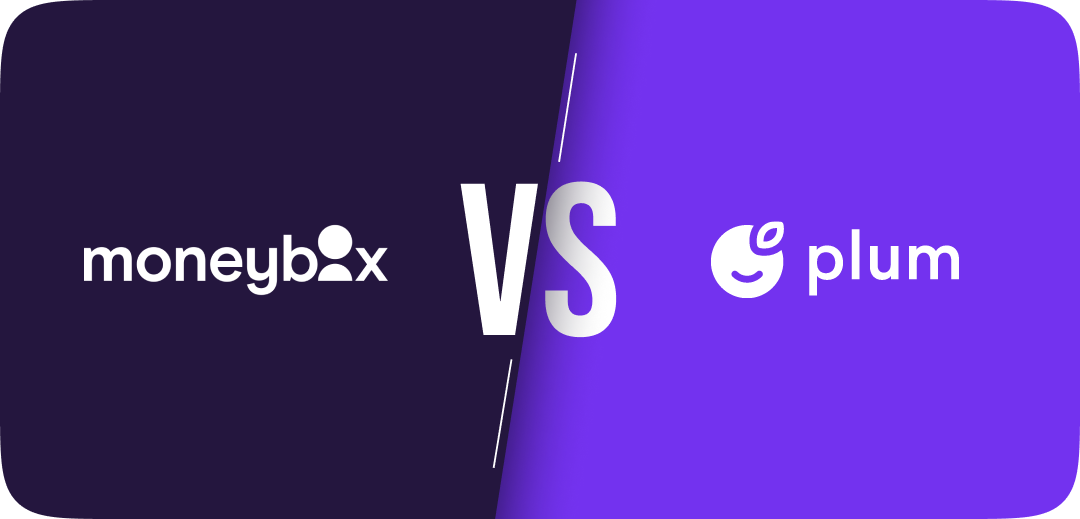FEATURED ARTICLE
Plum vs Moneybox - Which is the best personal finance app?

Ainsley Bilton
July 7, 2023 •6 min read
TABLE OF CONTENTS
Savings
Investments
Budgeting / Analytics
Integration & compatibility
Comparison table
With so many of us turning to apps to help us with our financial journey it is important to find the app that works best for you! Everyone has a different situation and unique financial goals which makes managing your finances incredibly personal. With so many of us turning to apps to help us with this journey it is important to find the app that fits your unique needs.
Two popular apps that consumers turn to for help with managing their money are Plum and Moneybox. Both apps offer a comprehensive way to manage your personal finances, but the two have several different features and benefits which this blog post will break down so you can find what works best for you!
Before we discuss the specific features of each app it is important to note that Plum offers 4 subscription tiers ranging from free to £9.99 a month for their Premium plan, and Moneybox does not have a subscription fee however there is a fee associated with investing in the app.
Savings
Both apps are geared towards helping customers to save money however, how they each go about this is slightly different from one another. Let’s start by looking at Plum.
For Plum, savings is a major focus and one way they help customers save is with their savings pockets. They offer easy-access interest pockets with a variable rate and the ability to create and customize your savings pockets to your desires! The number of savings features differs per plan with limitations on the number of savings pots and the ability to set smart savings rules limited to paid subscriptions only.
Plum also offers several automatic savings tools to help you reach your financial goals fast. Plum can analyze your transactions to identify regular income, rent, bills, and spending. From here you can set it up to calculate the amount that can safely be set aside every 4-5 days and Plum will transfer this via direct debit.
Plum offers several different savings rules that you can put in place like round-ups, taking part in their 52-week challenge, or saving for a rainy day which sets aside a calculated amount weekly.
Plum also allows you to select a savings mode ranging from ‘Chilled’ at 25% to ‘Beast Mode’ at 75%. For users looking to aggregate their savings from multiple accounts to one platform, another great option is Emma which offers savings pots at a competitive rate of 3.51% AER. With Emma, you can transfer money from multiple bank connections to create separate pots for each of your savings goals!
Now onto Moneybox.
Helping customers save is also a main focus of the Moneybox app. Compared to Plum they take a slightly different approach to delivering this to their customers. The app does so by offering 5 different savings accounts for customers to choose from for their needs, each with a different savings rate. The accounts vary in the interest rates and withdrawal notice with the longer withdrawal notices typically offering higher interest rates.
Moneybox takes more of a long-game view with its approach to helping consumers to save. As part of this, they offer a home-buying ISA account which offers a deposit boost from the government up to £4000 per tax year. Their deposit-boosting Lifetime ISA gets you a free 25% govt. bonus on top of everything you set aside, up to £4000. They also offer what they call a “Home-buying Gifts” feature which allows friends and family to contribute to your Cash Lifetime ISA through a unique gift link.
Investments
Plum has an investment platform in the app which allows users to invest in full and fractional shares of both funds and stocks as well as a number of funds. For free users, they have access to stocks but not to any funds in the investment platform.
For those looking to invest regularly, Plum offers a paid premium plan (for £9.99 p/m) that offers an additional 9 funds to invest in on top of the 12 funds available to free users. Plum allows you to automate your investing by simply selecting the amount, frequency, and where you want it to be allocated. From there Plum will do the rest. Plum allows you to invest in funds and stocks with as little as £1. On top of the available funds Plum also enables users to trade commission-free on more than 3000 American stocks.
Investment is a major focus for Moneybox. Moneybox offers a range of starting options, funds, as well as US Stocks. Moneybox also offers a stocks and shares ISA which earns 3.25% AER (Variable) on any money you set aside so you can earn interest on your money before you start investing. Moneybox has two ways to invest with their range of passive funds with either their starting options or customised allocation funds.
The way that they break down their starting options are “cautious, balanced, and adventurous” with the option to go with the socially responsible alternative to each. For investors who are looking to be more active in their investing, Moneybox also offers the ability to customise your investing allocations with a full range of US stocks to choose from. Moneybox allows customers to invest with as little as £1 and they can choose to automate their investments on a weekly basis or simply as a one-off buy. For those who prefer to create a diversified portfolio with funds, Moneybox offers 24 funds to choose from. Overall for those looking for an app that will help them to grow their investments, Moneybox is a great option for both beginners just starting their portfolio and experienced investors looking to grow their assets.
Budgeting / Analytics
Many consumers turn to financial apps for their ability to track spending and income in real time. These real-time analytics and transaction tracking allows for accurate and automated budgeting to see where your money is going and make more informed decisions.
Plum has a few features to help their consumers better budget their money. Plum’s money maximiser is designed to provide an overview of your spending so you can stay on track with how much you have already spent compared to how much you have left for a certain period whether that be daily, weekly, or monthly. Plum’s Money Maximiser also automatically tracks your transactions and breaks them down daily so you can see exactly where your money is going. By linking to your banks and credit cards Plum creates one space to aggregate your incoming and outgoing transactions to make budgeting easy. It is important to note that these money maximizer features are limited to users paying for an ultimate or premium plan.
Unlike other competitors like Emma, Plum does not allow users to create budgets based on custom categories rather the app only budgets for users to spend a certain amount of money in a given time frame.
Unlike Plum, Moneybox does not provide budgeting tools in the app. Moneybox has a greater focus on helping you make the most of your money for the long term with the money you have already allocated to saving and investing.
Integration & compatibility
Another important aspect to consider when choosing a financial app that is right for you is ensuring it is compatible with your bank and credit cards. Both Plum and Moneybox connect to major banks and credit cards in the UK. Plum has 20 integrations in their app plus the ability to create unlisted accounts. Unlike Plum, Moneybox does not require you to connect your bank accounts and credit cards to have an overview of your finances and only requires a bank connection to transfer money to either a savings or investment account within the Moneybox app.
Overall, both Plum and Moneybox are great financial tools to help take control of your finances but how these tools do so are very different. Depending on your goals and what you are looking to get out of your financial app Plum and Moneybox offer great tools. For those looking to manage their finances for the day-to-day Plum is a great choice while for those looking to set themselves up for long-term financial success, Moneybox has a great offering. For those looking for an app that allows them to both manage the day-to-day and plan for the future, Emma offers both budgeting and spending tools as well as the ability to save and invest in the platform.
Comparison table
We have taken the free and most expensive plans for a quick comparison
| Plum Free | Plum Premium | Moneybox | |
| Fees | free | £9.99 monthly | Free +investment fees |
| Savings accounts | -one savings pocket -automatic deposits -weekly deposits | -money maximiser feature -1p challenge feature -naughty rule feature, rainy days - pay day features, 52 week challenge, rainy days | -5 different account options -Varying interest rates per account & notice period -Home buying ISA |
| Savings rate | 2.99% AER | 3.82% AER | 3% AER simple saver account 3.75% AER 32 day notice 3.72% AER 45 day notice 4% AER 95 day notice 3.98% AER 120 day notice |
| Investing options | No investment for free users | access to 3000+ stocks -access to 9 premium funds + 12 standard funds | -Stocks & shares ISA -Passive funds for beginners with 3 different tiers -Custom allocations with 24 funds to choose from |
| Investing fees | No investment for free users | Included in subscription fee | -£1 investment fee-platform fee 0.15-0.45% -Annual fund provider cost 0.12-0.58% |
| Compatability | 20 bank connections available | 20 bank connections | Connect one account for direct debit payments |
| Additional | -Access to cashback offers in the app -Plum card |
** All facts and figures are accurate at the time of writing July 7th, 2023.
References:
Plum Website
You may also like
Check out these related blog posts for more tips
© 2025 Emma Technologies Ltd. All Rights Reserved.
Emma is registered and incorporated in England and Wales.
Emma Technologies Ltd is an appointed representative of RiskSave Technologies Ltd, which is authorised and regulated by the Financial Conduct Authority (FRN 775330).
Payment services (Non MIFID or Deposit related products) for Emma Technologies Ltd are provided by The Currency Cloud Limited. Registered in England No. 06323311. Registered Office: Stewardship Building 1st Floor, 12 Steward Street London E1 6FQ. The Currency Cloud Limited is authorised by the Financial Conduct Authority under the Electronic Money Regulations 2011 for the issuing of electronic money (FRN: 900199). For more detail on how your money is protected please see here. You can also find Currency Cloud's Terms of Use here.
Emma Technologies is an Introducer Appointed Representative of Quint Group Limited and not a lender. Quint Group Limited is authorised and regulated by the Financial Conduct Authority (Firm Reference Number 669450). Monevo Limited is an Appointed Representative of TransUnion International UK Limited. TransUnion is authorised and regulated by the Financial Conduct Authority (Firm Reference Number 737740). Emma Technologies introduces customers first to Quint Group Limited, as a licensed credit broker, who then refers on to Monevo Limited.
Emma is registered with the Financial Conduct Authority under the Payment Services Regulations 2017 for the provision of payment services.
Financial Conduct Authority Reg Nr: 794952.
Company Registration Number: 10578464.
Data Protection Registration Number: ZA241546.
All testimonials, reviews, opinions or case studies presented on our website may not be indicative of all customers. Results may vary and customers agree to proceed at their own risk.
Resources: Cancel subscriptions, Cashback offers, Who charged me, Rent Reporting, Budgeting, Investment universe, Emma vs Moneyhub.
Featured cashback offers: Samsung, SimplyCook, NordVPN, Audible, M&S Homeware.









